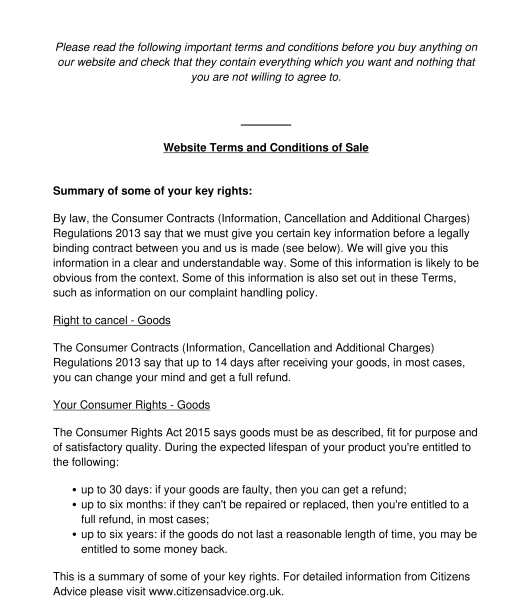 27/09/2025
27/09/2025

Answer a few questions and your document is created automatically.

Your document is ready! You will receive it in Word and PDF formats. You will be able to modify it.

 27/09/2025
27/09/2025
 Word and PDF
Word and PDF
 6 to 8 pages
6 to 8 pages
Online terms and conditions of sale will set out the basis on which a user purchases goods, services and/or digital content from a website in England and Wales. Terms and conditions of sale will form a contractual agreement between a consumer* and an online retailer.
A consumer is an individual who purchases goods or services from a business for personal use. Consumers have certain rights and protections.
Terms and conditions of sale will constitute a contractual agreement. These terms and conditions will apply when a consumer purchases goods or services from an online retailer.
Terms and conditions of use will address how a website may be used. These terms and conditions will cover factors such as security, safety and intellectual property.
There are many crossovers between consumer rights in relation to in-store purchases and in relation online purchases. There are, however, some differences. In particular, cancellation rights exist for online sales. Therefore, separate terms and conditions will be used for in-store purposes.
Yes, there is certain information which should always be communicated to consumers. The best approach is to include this information in the terms and conditions of sale.
The terms and conditions of sale should be placed on the website, in an accessible location. Each consumer should be made aware of the terms and conditions once they make a purchase. The simplest way to deal with this is to ask the consumer to indicate their acceptance of the terms and conditions by clicking a box.
Terms and conditions of sale should be used in conjunction with:
Terms and conditions of sale will include the following information:
The following legal provisions will be relevant to the terms and conditions:
You fill out a form. The document is created before your eyes as you respond to the questions.
At the end, you receive it in Word and PDF formats. You can modify it and reuse it.
A guide to help you: Signing Documents in England and Wales
Website Terms and Conditions of Sale - Sample, template
Country: United Kingdom